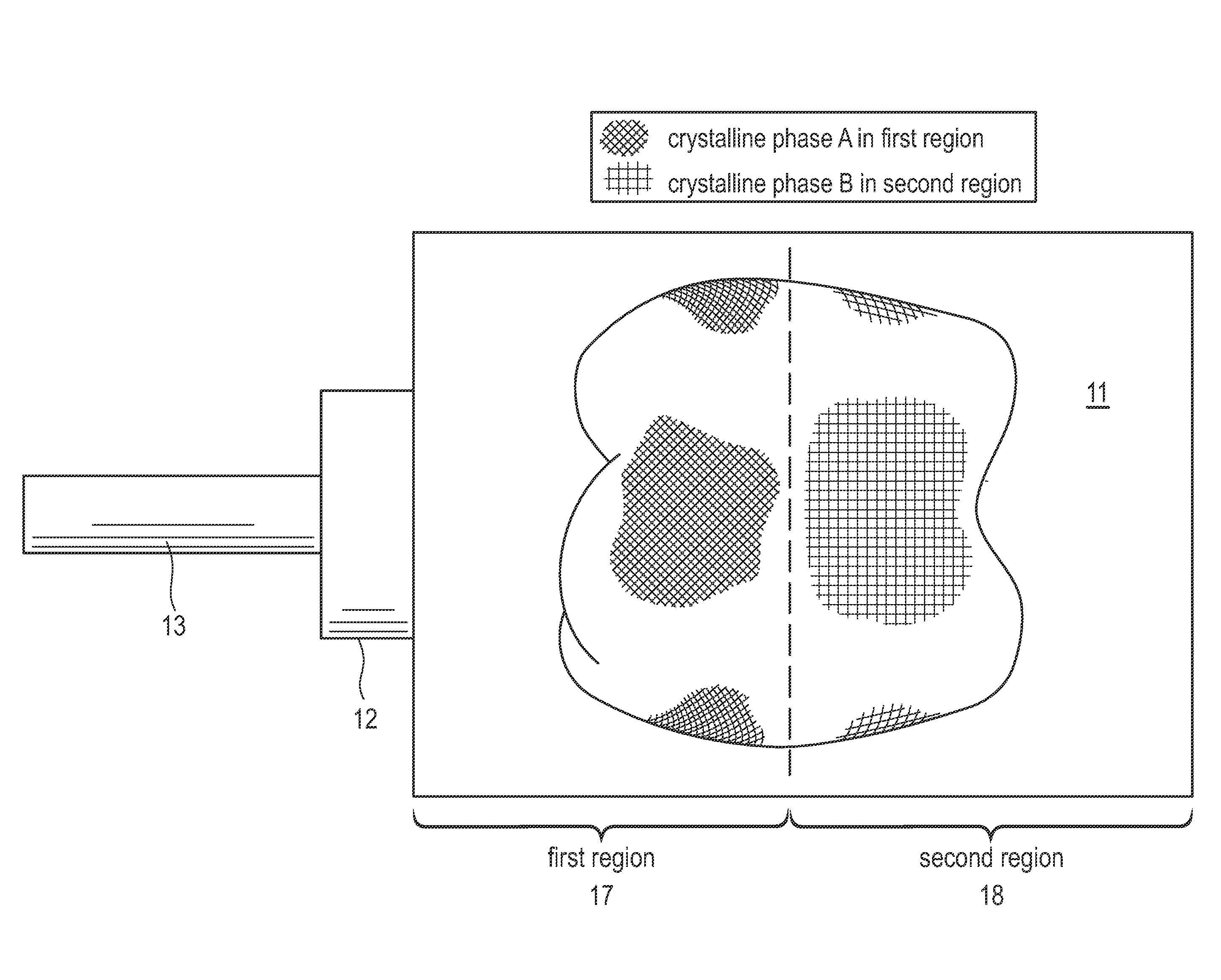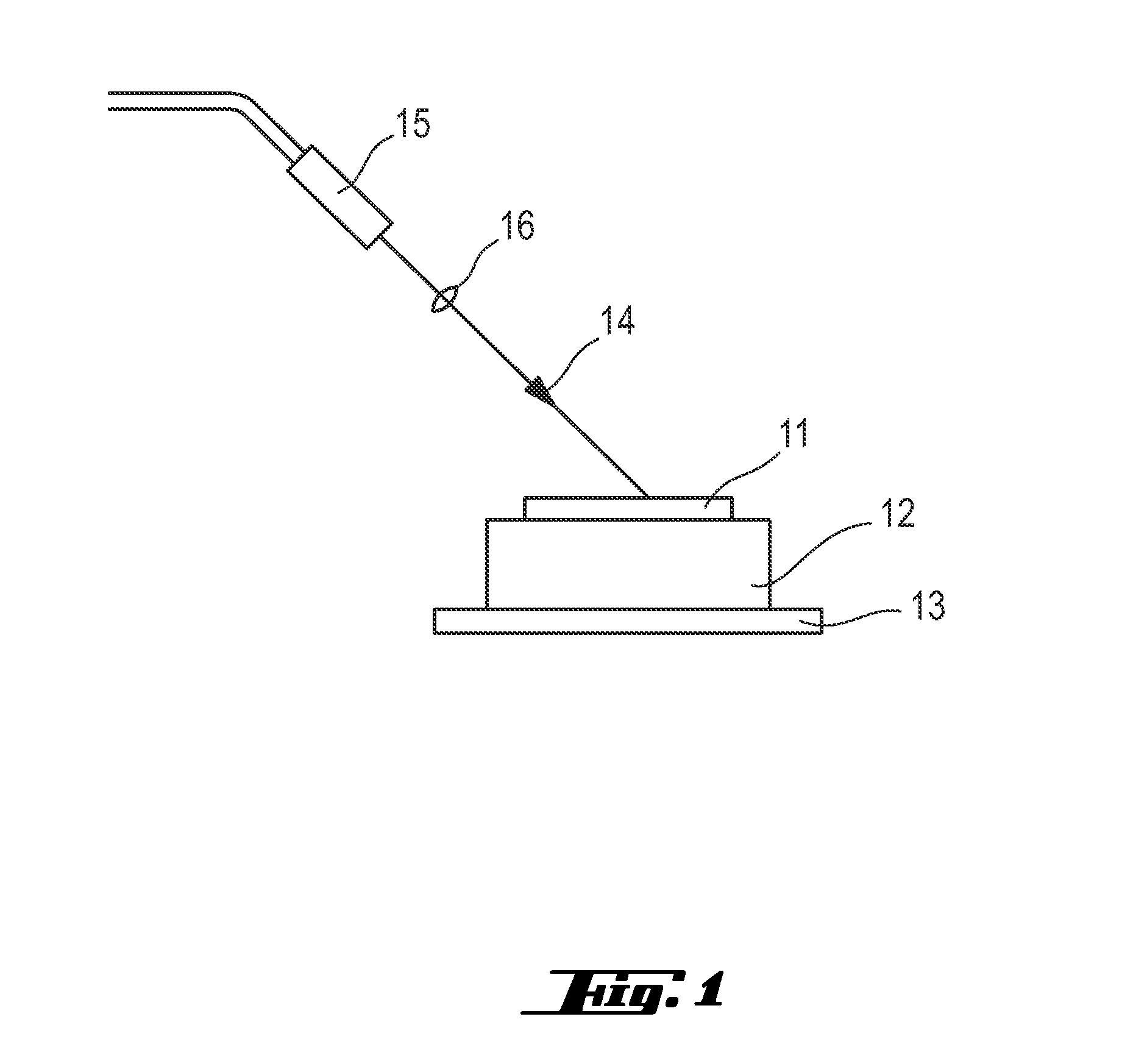Prosthetic element
a prosthetic element and element technology, applied in the field of prosthetic elements, can solve the problems of insufficient edge strength of the restoration, increased tool wear during finishing, and insufficient strength of the edge preparation of the restoration, and achieve the effect of limited service li
- Summary
- Abstract
- Description
- Claims
- Application Information
AI Technical Summary
Benefits of technology
Problems solved by technology
Method used
Image
Examples
example 1
[0097]A bar shaped sample 11 having the above composition is put on a ceramic base plate 12 (table) which itself is arranged on a metal support 13. This arrangement is placed in a chamber where the sample is treated by laser irradiation 14 using a LIMO high power continuous wave (cw) diode laser 15 (wavelength λ=808 nm, optical power=max. 350 W, spot diameter dF=6 mm, uniform beam profile). The laser beam is thereby directed through a focusing lens 16.
[0098]More specific details regarding the laser irradiation in Experiments No.s 1.1 and 1.2 are given in the following:
Experiment No.#1.11.2Sample Positionon tableon tableSample StatenotnotnucleatednucleatedBeam Propagationfocusedfocusedangle 45°angle 45°Beam Diametermm66Optical PowerW180180IntensityW / cm2636.6636.6Irradiation timeMin57
[0099]A comparison of Experiments 1.1 and 1.2 reveals that during the laser irradiation treatment a translucent violet colour starts to spread from the top to the bottom, followed by a white colour propag...
example 2
[0100]Samples having the above composition are preheated in a first step during 1 min at 150 W and 1 min at 120 W before laser irradiation treatment using the laser specified in Example 1. More specific details regarding the laser irradiation in Experiment No. 2 are given in the following:
Experiment No.#2Sampleon tablePositionSample Statenucleated glassBeamfocusedPropagationangle 45°Beam Diametermm6Optical PowerW190IntensityW / cm2672.0IrradiationMin3time
[0101]By this treatment, a glass-ceramic sample comprising crystalline phases of white and yellow colour is obtained. The presence of the crystalline phases generated by laser irradiation is confirmed by XRD (X-ray diffraction) measurements which reveal the presence of 39.8% of beta-spodumene (LiAlSi2O6), 16.3% of lithium disilicate, 0.8% of dilithium phyllo-disilicate, 6.1% of lithiophosphate (Li3PO4), and 0.4% of petalite (LiAlSi4O10).
[0102]Thus, the examples confirm crystallization in the samples by laser irradiation energy using a...
PUM
| Property | Measurement | Unit |
|---|---|---|
| wavelength | aaaaa | aaaaa |
| wavelength | aaaaa | aaaaa |
| wavelength | aaaaa | aaaaa |
Abstract
Description
Claims
Application Information
 Login to View More
Login to View More - R&D
- Intellectual Property
- Life Sciences
- Materials
- Tech Scout
- Unparalleled Data Quality
- Higher Quality Content
- 60% Fewer Hallucinations
Browse by: Latest US Patents, China's latest patents, Technical Efficacy Thesaurus, Application Domain, Technology Topic, Popular Technical Reports.
© 2025 PatSnap. All rights reserved.Legal|Privacy policy|Modern Slavery Act Transparency Statement|Sitemap|About US| Contact US: help@patsnap.com



